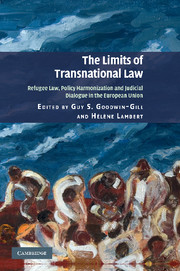 The Limits of Transnational Law
The Limits of Transnational Law Book contents
- Frontmatter
- Contents
- Notes on contributors and editors
- Acknowledgements
- Abbreviations
- 1 Transnational law, judges and refugees in the European Union
- 2 Where is the reference? On the limited role of transnational dialogue in Belgian refugee law
- 3 Transnational refugee law in the French courts: deliberate or compelled change in judicial attitudes?
- 4 The use of foreign asylum jurisprudence in the German administrative courts
- 5 The solipsistic legal monologue of Italian authorities
- 6 ‘Thou shalt not judge’ … Spanish judicial decision-making in asylum and the role of judges in interpreting the law
- 7 The British judiciary and the search for reciprocal relations with its continental partners
- 8 Speaking across borders: the limits and potential transnational dialogue on refugee law in Ireland
- 9 The absence of foreign law in Danish asylum decisions – quasi-judicial monologue with domestic policy focus?
- 10 Foreign law in Swedish judicial decision-making: playing a limited role in refugee law cases
- 11 The search for the one, true meaning …
- Bibliography
- Index
3 - Transnational refugee law in the French courts: deliberate or compelled change in judicial attitudes?
Published online by Cambridge University Press: 06 July 2010
- Frontmatter
- Contents
- Notes on contributors and editors
- Acknowledgements
- Abbreviations
- 1 Transnational law, judges and refugees in the European Union
- 2 Where is the reference? On the limited role of transnational dialogue in Belgian refugee law
- 3 Transnational refugee law in the French courts: deliberate or compelled change in judicial attitudes?
- 4 The use of foreign asylum jurisprudence in the German administrative courts
- 5 The solipsistic legal monologue of Italian authorities
- 6 ‘Thou shalt not judge’ … Spanish judicial decision-making in asylum and the role of judges in interpreting the law
- 7 The British judiciary and the search for reciprocal relations with its continental partners
- 8 Speaking across borders: the limits and potential transnational dialogue on refugee law in Ireland
- 9 The absence of foreign law in Danish asylum decisions – quasi-judicial monologue with domestic policy focus?
- 10 Foreign law in Swedish judicial decision-making: playing a limited role in refugee law cases
- 11 The search for the one, true meaning …
- Bibliography
- Index
Summary
Introduction
French judges have a long history of dialogue among themselves. This dialogue started between the administrative judge (namely the Conseil d'État or Council of State, the highest administrative court) and the civil judge (namely the Cour de Cassation, the highest civil court), with the Tribunal des Conflicts ultimately competent to decide who shall be competent. This dialogue was progressively extended to include the Constitutional Court (Conseil Constitutionnel) following its establishment in 1958. The scope of this dialogue was also widened to include the European Court of Justice (ECJ) (and its dialogue with the Council of State, in particular) through the preliminary ruling procedure, and the European Court of Human Rights (ECtHR). In fact, it is often argued that European law has been a key element in the growth of comparative method in both the Council of State and the Cour de Cassation. Finally, this dialogue was extended to include the highest courts of other countries (such as between the House of Lords and the Council of State). However, citing or referring to the jurisprudence from another national jurisdiction remains a rare exercise in French administrative courts. Thus, the full impact of foreign law on French decisions may often be a matter of speculation. That said, important information can be found in the conclusions of the commissaire du Gouvernment (the rapporteur public) as well as in the annual and special reports of the Council of State.
- Type
- Chapter
- Information
- The Limits of Transnational LawRefugee Law, Policy Harmonization and Judicial Dialogue in the European Union, pp. 35 - 56Publisher: Cambridge University PressPrint publication year: 2010
- 1
- Cited by
